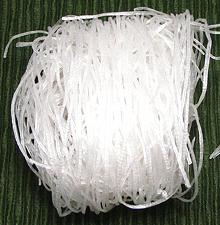Arrowroot
 [Obedience Plant, Bermuda Arrowroot, Araru, Ararao; bilathi koova
(Kerala, India); Maranta arundinacea]
[Obedience Plant, Bermuda Arrowroot, Araru, Ararao; bilathi koova
(Kerala, India); Maranta arundinacea]
This plant is native to the tropical Americas, where it has been used
as food for at least 10,200 years, and cultivated for more than
7,700 years. It is best know for a starch made from long thin rhizomes
of young plants, but older, larger rhizomes are harvested to be used
similarly to yams. They are fairly neutral in flavor, but noticeably
sweet. Arrowroot is now grown commercially through the tropics
worldwide. The larger photo specimen was 10-1/2 inches long, 5 inches
across and weighed 3 pounds 9-1/4 ounces. It was not the largest in
the bin.
The starch is preferred as a thickening agent for some uses because
it has unique properties compared to cornstarch and potato starch.
Particularly, it is neutral in flavor, will thicken at a lower
temperature, freezes without breaking, and will thicken acidic
liquids. The starch has been most used as a thickener in English
cuisine. In Korea and Vietnam it is made into noodles.
More on Gingers.
 Arrowroot plants grow to up to 6 feet tall, and are nice garden
decoratives, but only in the tropics, only as far north as southern
Florida. Arrowroot starch is extracted from the rhizomes of plants about
1 year old, when they are long, narrow, have nearly white skins, and are
easy to grind up. Fresh rhizomes for cooking are from older plants, with
medium tan skins, but the skins are still very thin.
Photo by Fpalli, distributed under license Creative
Commons
Attribution-ShareAlike 3.0 Unported.
Arrowroot plants grow to up to 6 feet tall, and are nice garden
decoratives, but only in the tropics, only as far north as southern
Florida. Arrowroot starch is extracted from the rhizomes of plants about
1 year old, when they are long, narrow, have nearly white skins, and are
easy to grind up. Fresh rhizomes for cooking are from older plants, with
medium tan skins, but the skins are still very thin.
Photo by Fpalli, distributed under license Creative
Commons
Attribution-ShareAlike 3.0 Unported.
Buying:
Fresh Arrowroot Rhizomes are not at all common
in North America, but I have found them in a large Asian market here in
Los Angeles (San Gabriel).
Storing:
Fresh rhizomes can be stored similarly to
potatoes, in a cool place. They will still be solid for more than
a week,but will steadily shrink.
Cooking:
Arrowroot rhizomes are very durable in wet
cooking, becoming edible in about 15 minutes, but it is still quite
firm after an hour. The rhizomes are fibrous, but the fibers are so
soft they don't interfere with eating.
Arrowroot Starch
 [Arrowroot Flour, Arrowroot Powder]
[Arrowroot Flour, Arrowroot Powder]
This starch is available from most supermarkets in North America. The
flavor is very neutral and it is better for thickening acidic foods than
Cornstarch. Its thickening power is as much as 1.5 times Cornstarch,
so use less for the same thickening. It will break down from prolonged
heat or break quickly if it reaches a boil.
Arrowroot gel freezes well, and will thicken well below the boiling
point so can be used for fragile sauces. It produces a clear sauce,
with an appearance less glossy than cornstarch. Arrowroot should not be
used in dairy based sauces as it turns them slimy. It should be made
into a slurry with cold water before adding to hot liquids, but
smaller amounts can be sprinkled over a finished dish and stirred in
for last minute thickening. Used this way, it will not clump like
cornstarch. Always keep arrowroot thickened soups and sauces below
the boiling point.
Arrowroot Vermicelli
 [242; Mien Dong Nguyen Chat (Viet)]
[242; Mien Dong Nguyen Chat (Viet)]
These noodles, made in Vietnam, are a bit strange. Just soaked, they
have a somewhat unpleasant flavor. Boiled, whether soaked first or not,
mere seconds after they are tender they start becoming mush (but the
flavor is somewhat better). I can only presume this is supposed to
happen to provide a thickening effect in soup they are added to. Ingred:
pure flour of arrowroot (arrowroot starch), salt, water. 0.033 diameter,
in 1.5 ounce skeins.
Buying:
I have found these in one of the large Asian
markets here in Los Angeles (San Gabriel).
gg_arrowz 170420 r 190319 - www.clovegarden.com
©Andrew Grygus - agryg@aaxnet.com - photos on
this page © cg1 - Linking to and
non-commercial use of this page permitted
 Arrowroot plants grow to up to 6 feet tall, and are nice garden
decoratives, but only in the tropics, only as far north as southern
Florida. Arrowroot starch is extracted from the rhizomes of plants about
1 year old, when they are long, narrow, have nearly white skins, and are
easy to grind up. Fresh rhizomes for cooking are from older plants, with
medium tan skins, but the skins are still very thin.
Photo by Fpalli, distributed under license Creative
Commons
Attribution-ShareAlike 3.0 Unported.
Arrowroot plants grow to up to 6 feet tall, and are nice garden
decoratives, but only in the tropics, only as far north as southern
Florida. Arrowroot starch is extracted from the rhizomes of plants about
1 year old, when they are long, narrow, have nearly white skins, and are
easy to grind up. Fresh rhizomes for cooking are from older plants, with
medium tan skins, but the skins are still very thin.
Photo by Fpalli, distributed under license Creative
Commons
Attribution-ShareAlike 3.0 Unported. [Obedience Plant, Bermuda Arrowroot, Araru, Ararao; bilathi koova
(Kerala, India); Maranta arundinacea]
[Obedience Plant, Bermuda Arrowroot, Araru, Ararao; bilathi koova
(Kerala, India); Maranta arundinacea]
 [Arrowroot Flour, Arrowroot Powder]
[Arrowroot Flour, Arrowroot Powder]
 [242; Mien Dong Nguyen Chat (Viet)]
[242; Mien Dong Nguyen Chat (Viet)]